Kimberly Steele (![[personal profile]](https://www.dreamwidth.org/img/silk/identity/user.png) kimberlysteele) wrote2023-08-16 10:31 am
kimberlysteele) wrote2023-08-16 10:31 am
Open Post and Garden Update
Here are some photos of my garden in lieu of a meatier post today -- I'll save the more gravitas-filled posts for a week when I've got more mojo. Change back to the school schedule is rough! As usual, please feel free to comment but keep in mind I don't publish what I consider "I don't do that anymore" swear words, such as rhymes with duck, skit, runt, etc.
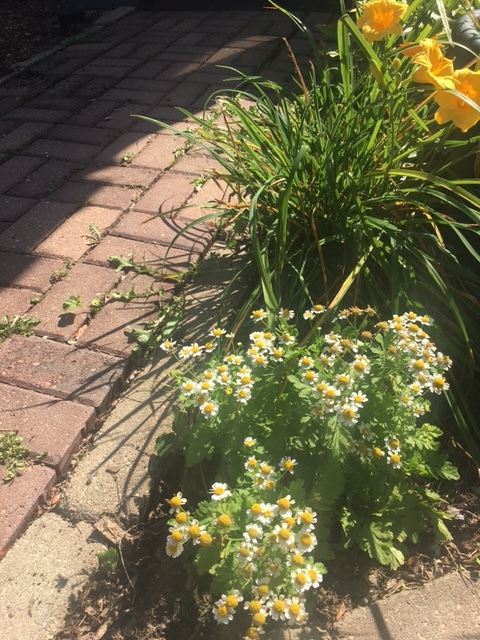
Recently planted feverfew nestled in the bricks -- the hosta hated it in this space so I transplanted it elsewhere.

I'm trying to propagate roses from cuttings this year. This one is tucked into the raised bed by a tomato and some borage. I'm just going to leave it in here until next spring and hope for the best.

We used to have two old and dying Siberian elms in this area when we moved in 8 years ago. The stone and the paths weren't there, it was just huge, falling elms in a sea of waist-high grass. Tragically, the elms had to be cut down because they were falling down. Once my husband put in the stone paths, I noticed elm sprouts coming up between the mulch and the stone. I shepherded/trimmed them into the rectangular bush you see on the right. It has ended up being a perennial elm bush. Whenever new elm sprouts come up, I transplant them and try to start new elm bushes. I have one started on the bottom left of the path south of the visible boxwood. My plan is to eventually move the boxwoods and border every stone path in transplanted elm bushes.

Rudibeckia or Black Eyed Susan is a native plant in my upper part of Illinois. In the back I've got some double orange daylilies, the dark red one called Bela Lugosi which is my favorite, and some overgrown Russian sage.
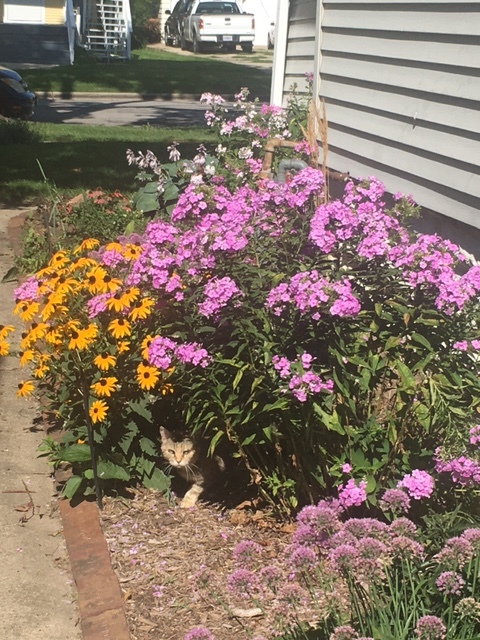
My neighbor's gorgeous phlox, more Rudibeckia, and Ms. Blondie Piggy, resident feral.
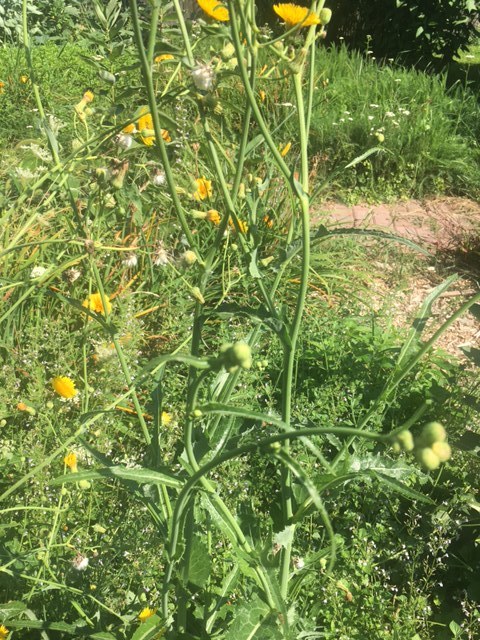
I grow elecampane. It's very weedy. The only way I have ever used it is tincturing the root. Tincturing is a fancy word for chopping up plant material and letting it stew in vodka in a jar. I notice with myself that I tend to grow lots of herbs and then mismanage my time so that I don't end up doing anything with them (except observing their beauty, which I guess counts for something).

My overgrown herb garden. Upper left is yarrow, upper right is lemon balm and catmint, lower right is sage and native Midwest monarda/bee balm, and left is spearmint.
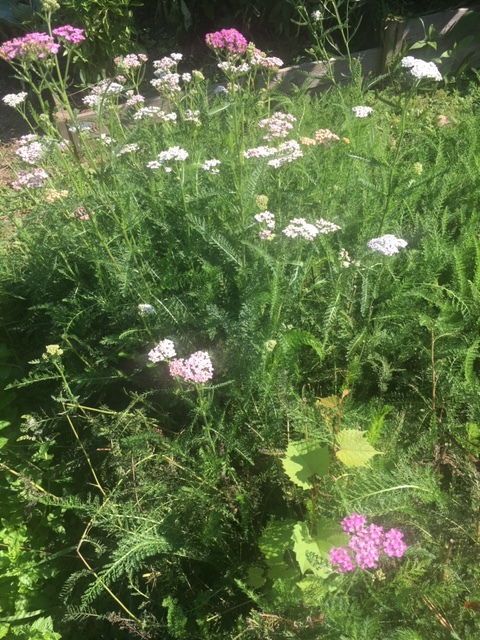
Yarrow on its second bloom this year.

The pussy willow that was started from donated sticks of my neighbor's tree. And Ms. Piggy stalking me for snacks.

Tommy, Piggy's son, saying Hi by the Brussels sprouts.
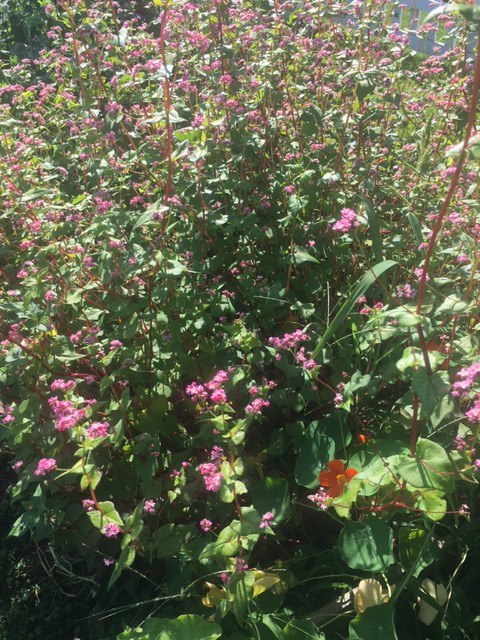
I grew buckwheat this year. Not sure what to do with it though. The orange bloom on the right is nasurtium.

Coneflower (Echinacea purpurea) I started from seed, catmint, iris, tall grasses, and rose. Still chipping away at that lawn, year by year. Someday I will make it disappear entirely.
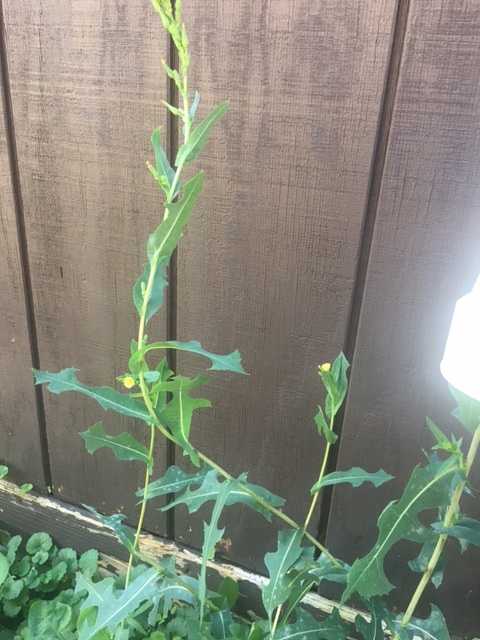
Wild lettuce growing by the house. I made a tincture of it this year. It's a natural pain reliever also known as wild opium.

Coneflower growing in a ring around an oak seedling that I've been growing for a few years.


In the Garden
I put in one little zinnia though, and it's grown into a happy orange-flowered mound. The butterflies like it. And I've got a rosemary plant that's trying to be a shrubbery. They like the heat-- might as well be cacti.
And I've picked fourteen pumpkins! I'm going to be cooking and freezing a bunch of them, because the caterpillars have been gnawing at them, and the compromised rind means they won't keep all that long (a good one can sit on the shelf over a year and still be good!). Have already eaten three, and they are sooo good. There are at least a couple that seem to have resisted the bugs pretty well, and also gotten fairly large-- those are the ones I'll be saving seeds from, for next year. This year's were grown from my 2-years-ago saved seeds-- it'll be my first attempt at basic selective breeding and I'm so excited! The bugs got in of course, and they have eaten most of the leaves off the vines-- it's been upper nineties and low 100s for a few weeks, and it weakens everything. But most of the pumpkins ripened anyway, and some of the vines are still hanging in there, so some of the still-green ones may make it, if they can survive until the heat breaks.
Since this is one of the mostly-dead times of year for gardening, I'm eagerly planning what to plant for the second growing season, starting next month :)